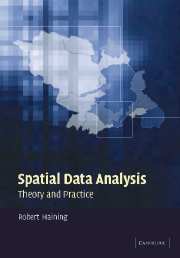Book contents
- Frontmatter
- Contents
- Preface
- Acknowledgements
- Introduction
- Part A The context for spatial data analysis
- Part B Spatial data: obtaining data and quality issues
- Part C The exploratory analysis of spatial data
- Part D Hypothesis testing and spatial autocorrelation
- Part E Modelling spatial data
- 9 Models for the statistical analysis of spatial data
- 10 Statistical modelling of spatial variation: descriptive modelling
- 11 Statistical modelling of spatial variation: explanatory modelling
- Appendix I Software
- Appendix II Cambridgeshire lung cancer data
- Appendix III Sheffield burglary data
- Appendix IV Children excluded from school: Sheffield
- References
- Index
9 - Models for the statistical analysis of spatial data
Published online by Cambridge University Press: 06 July 2010
- Frontmatter
- Contents
- Preface
- Acknowledgements
- Introduction
- Part A The context for spatial data analysis
- Part B Spatial data: obtaining data and quality issues
- Part C The exploratory analysis of spatial data
- Part D Hypothesis testing and spatial autocorrelation
- Part E Modelling spatial data
- 9 Models for the statistical analysis of spatial data
- 10 Statistical modelling of spatial variation: descriptive modelling
- 11 Statistical modelling of spatial variation: explanatory modelling
- Appendix I Software
- Appendix II Cambridgeshire lung cancer data
- Appendix III Sheffield burglary data
- Appendix IV Children excluded from school: Sheffield
- References
- Index
Summary
Data modelling enables the analyst to test hypotheses and to see to what extent a collected set of data support or refute a set of hypotheses. By specifying a model to represent the variation in data, rather than just testing a null hypothesis against a non-specific alternative (see chapters 7 and 8), the analyst is able to construct tests of hypothesis with greater statistical power. In the case of spatial data this includes modelling the spatial variation in the data.
Dobson (1999, pp. 10–11) describes a statistical model in information theory terms. Data represent measurements that consist of signal (the ‘message’ or ‘process’) distorted by noise. The variation in data is then composed of these two elements. The analyst constructs mathematical models that include both these components where the signal is regarded as deterministic and the noise is regarded as random. Combining these two components into a single model yields a probabilistic mathematical model called a statistical model. Another way she suggests of thinking of a statistical model is to consider the signal as a mathematical description of the important features of the data whilst the noise is the part of the data that is ‘unexplained’ by the signal component of the model. In descriptive spatial modelling the signal is a mathematical expression that describes spatial pattern or spatial structure, whilst in explanatory modelling it is a mathematical expression that incorporates predictors.
- Type
- Chapter
- Information
- Spatial Data AnalysisTheory and Practice, pp. 289 - 324Publisher: Cambridge University PressPrint publication year: 2003



